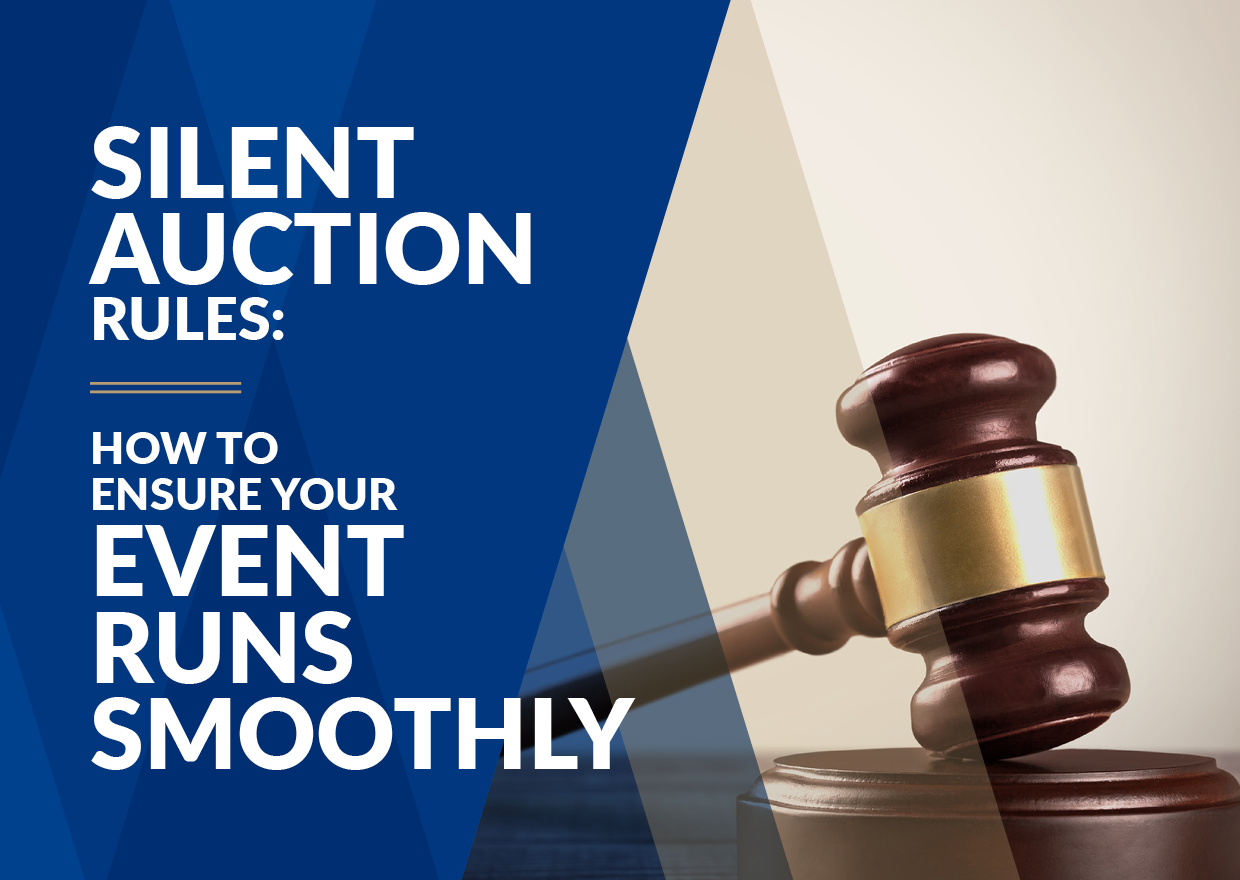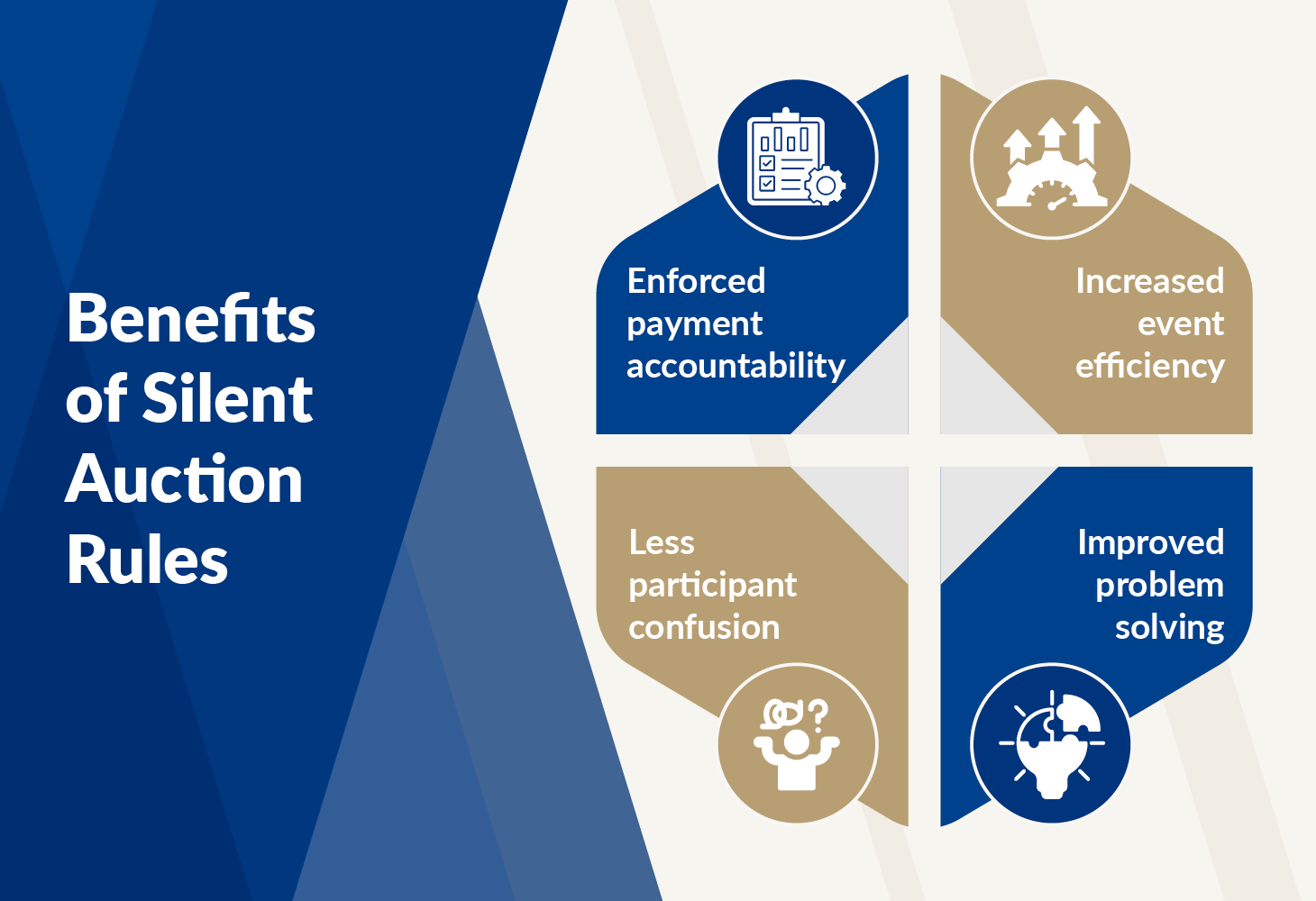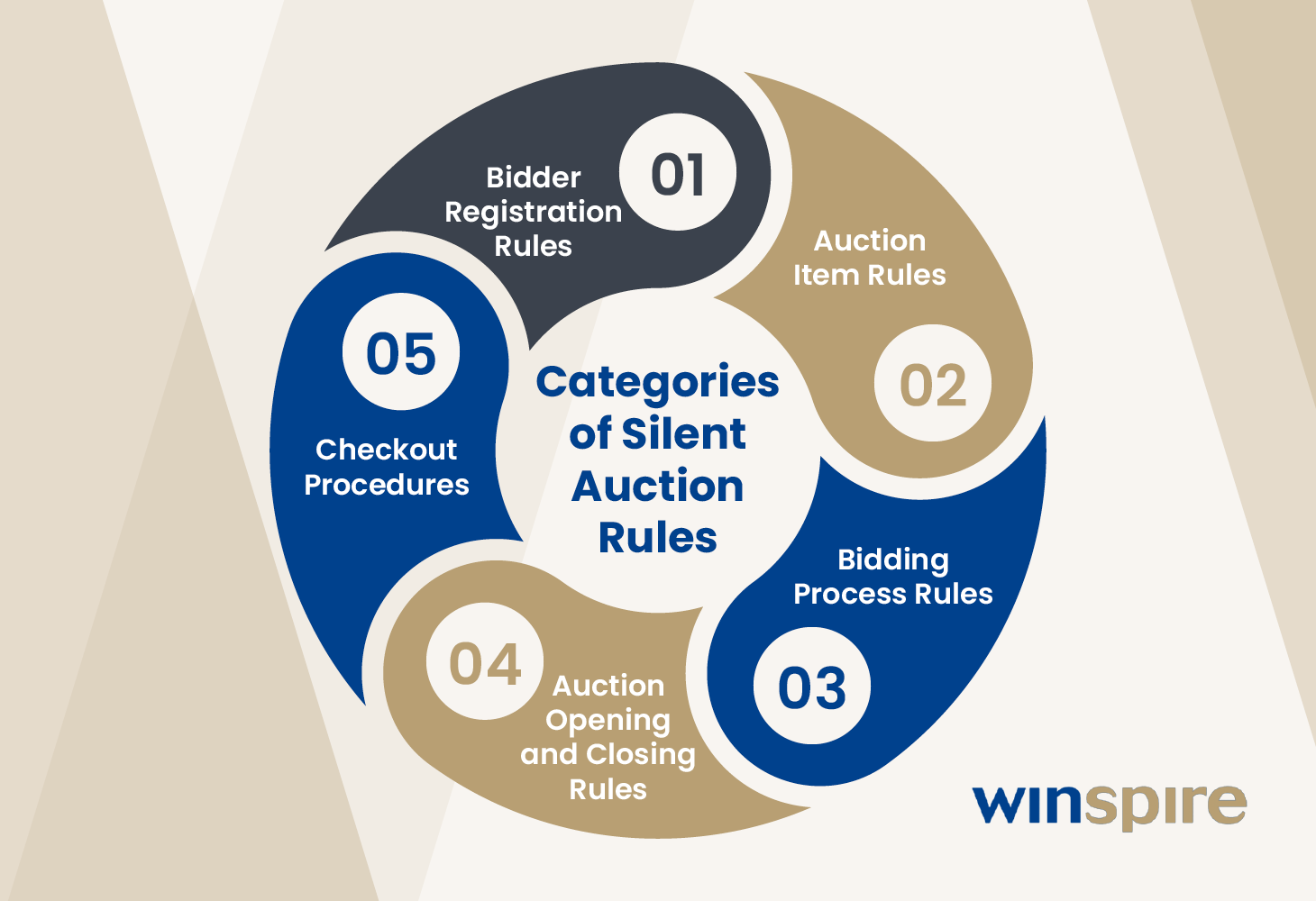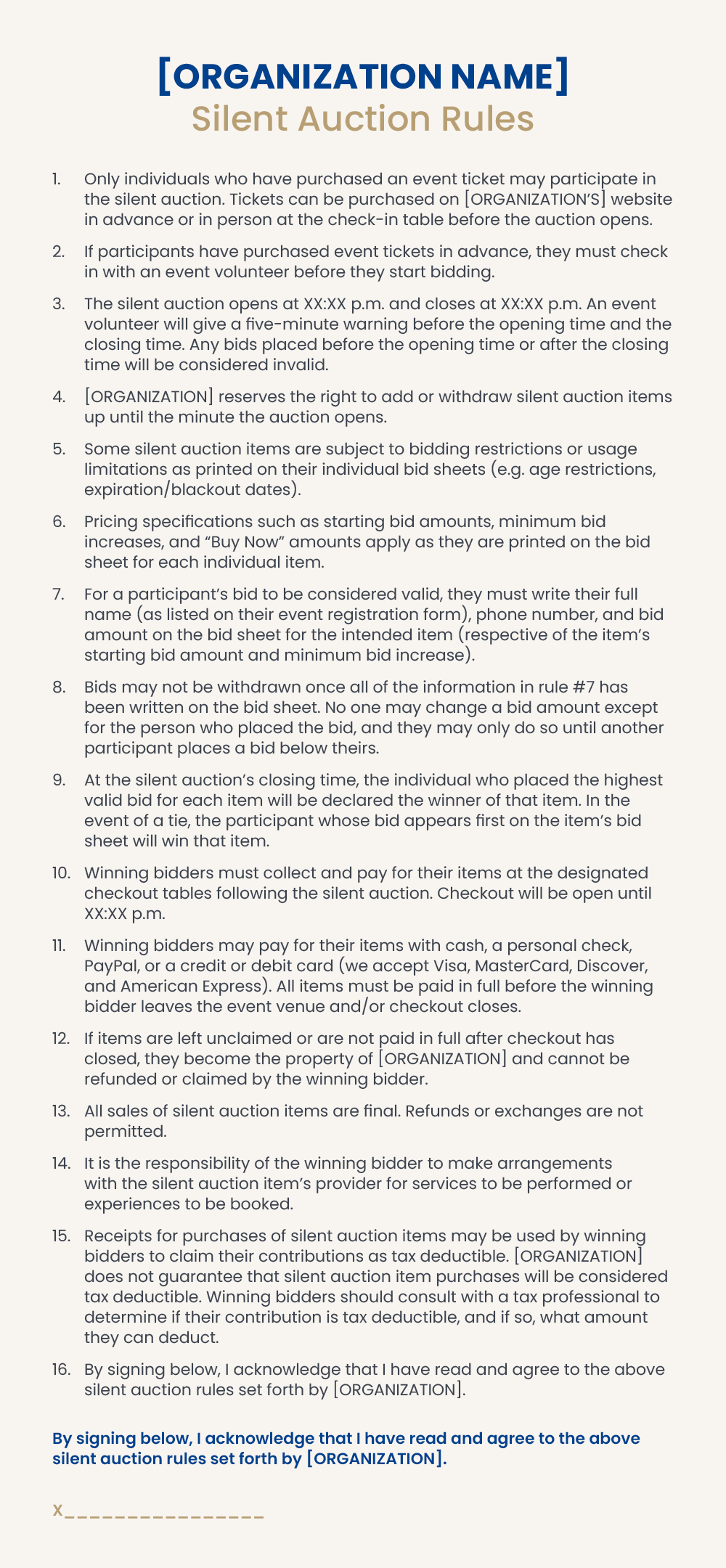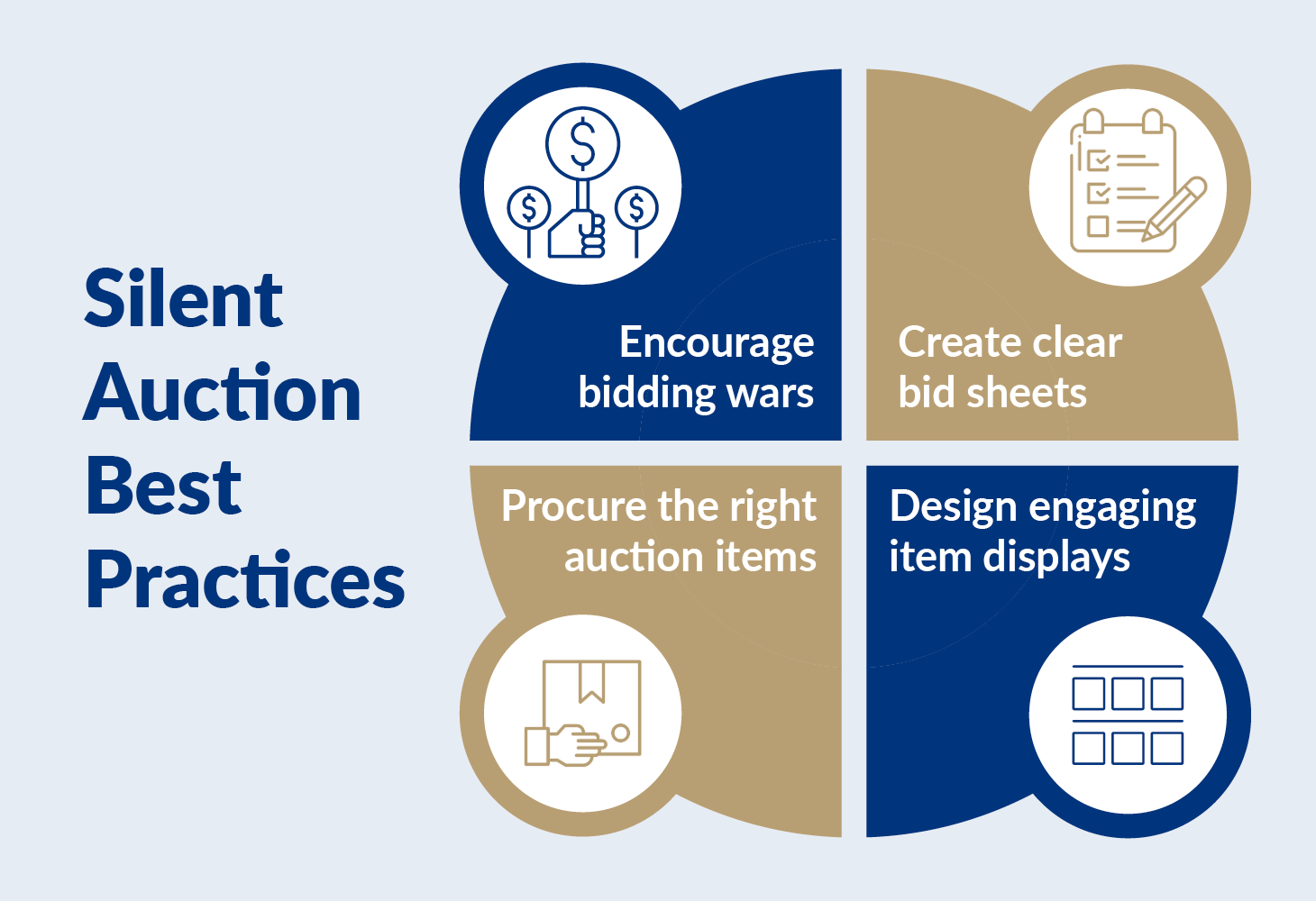If your nonprofit has hosted an auction before, you’ve probably noticed how exciting this type of fundraising event is for participants. Even a silent auction can create a fun, competitive atmosphere as supporters try to place the highest bids for the coveted prizes up for grabs.
However, it’s unwise to let auction participants enter into bidding wars without first establishing some rules of engagement. So, in this guide, we’ll teach you how to develop silent auction rules that keep your event running smoothly while still making it fun for participants. Here is what we’ll cover:
- Why are silent auction rules important?
- Categories of Silent Auction Rules
- Silent Auction Rule Sheet Example
- Additional Silent Auction Best Practices
Before we dive into what rules to implement at your silent auction, let’s begin by discussing why these guidelines are necessary in the first place.
Why are silent auction rules important?
At their core, the purpose of silent auction rules is similar to that of the rules for sports or board games: to promote fairness in a competition. Participants want to know that they all have an equal opportunity to bid on their favorite items and that the winners aren’t chosen based on any kind of favoritism on your nonprofit’s part.
By developing the right kinds of rules for your silent auction, your organization can also experience these benefits:
- Increased event efficiency. Your auction is more likely to start and end on time and have a faster checkout process if you create guidelines for these elements of the event in advance.
- Improved problem solving. If a dispute arises between supporters during the auction, you’ll have an official document to reference as you figure out a resolution and to back up your final decision.
- Less participant confusion. Clear rules can also serve as a reference for supporters if they don’t know how a silent auction works or if any misunderstandings occur with other participants, which can help to answer questions before they turn into disputes.
- Enforced payment accountability. Payment guidelines help ensure that winning bidders pay for the items they said they would in a timely manner, ensuring your nonprofit receives the fundraising revenue you were promised.
When you set rules that allow all of these aspects of your silent auction to go off without a hitch, your organization will appear trustworthy and professional. This boosts your reputation and encourages supporters to attend more of your nonprofit’s events in the future.
Categories of Silent Auction Rules
There are many different silent auction rules you could set depending on your organization’s priorities and desires for how the event will go. To make it easier for you to decide, we’ve broken down the most popular silent auction rules into five basic categories.
Note: These rules apply primarily to in-person, standalone silent auctions. You’ll need to adapt some guidelines for mobile bidding if your event is virtual and create a second set of rules if you host a silent auction and live auction during the same event.
Bidder Registration Rules
Start your silent auction off on the right foot by establishing guidelines for what will happen right after participants walk through the door. Here are some examples of bidder registration rules:
- Only supporters who have purchased an event ticket may bid in the silent auction.
- Participants must read and sign a copy of the rules upon registering for the auction.
- Pre-registered participants must check in with an event volunteer before they start bidding.
These rules promote fairness in terms of who gets to participate in your silent auction. Plus, they ensure that everyone agrees to the rules in advance, reducing the overall number of rule-breaking incidents and holding participants accountable if they violate a guideline.
Auction Item Rules
Developing guidelines regarding your silent auction items protects your nonprofit from various liabilities that may come up with item providers and auction participants. These may include:
- The right of your organization and item providers to add or withdraw items at will up until the auction opens
- The fact that all item sales are final and no refunds will be given to winning bidders
- The ability to specify limitations on individual items’ use—for example, stating that a gift certificate expires or that prizes that directly involve alcohol (such as craft beer samplers or wine tasting experiences) can only be sold to supporters aged 21 and up
Since listing out every limitation on each prize takes up a lot of space, only add general item-related rules to your official rule sheet, and include a clause that the “fine print” on all of your bid sheets (where you’ll specify limitations for each prize) has to be honored.
Bidding Process Rules
Bidding process rules help keep the peace among participants during your silent auction. Take the following considerations into account when establishing your event guidelines:
- What information (name, contact details, etc.) supporters need to include on the bid sheet for their bid to be valid
- Whether participants can change or withdraw their bids after they’ve been placed
- What to do in the event that an item’s winning bid is a tie
Item pricing also falls into this category of silent auction rules and should be treated similarly to individual prize limitations. Designate a starting bid amount and minimum bid increase on each item’s bid sheet, and include a general clause on your rule sheet that pricing specifications apply as listed.
Auction Opening and Closing Rules
This category of silent auction rules is also important for maintaining decorum, besides helping ensure the event runs efficiently and that winning bidders are chosen properly. In addition to specifying an opening and closing time for bidding, consider implementing these guidelines:
- The highest qualified bid (complete and otherwise in accordance with your event rules) wins the item.
- Bids placed before the official opening time or after the official closing time are considered invalid.
- Event volunteers must give five-minute warnings before bidding opens and closes.
When your silent auction is about to close, ensure your volunteers and staff are prepared, as closing is the time when disputes between participants are most likely to occur. During your pre-event training, teach everyone the best procedures for resolving conflicts and which auction rules are best to refer back to in these situations.
Checkout Procedures
Ensuring your silent auction runs smoothly doesn’t end when the closing bell rings. You also need to establish clear checkout procedures so that winning bidders will properly claim their items. Make sure to specify:
- Where and when winning bidders should pick up and pay for their items
- What payment methods you’ll accept
- Who is responsible for making arrangements to use certain prizes, such as booking vacations or coordinating services
- Whether receipts for auction items can be used for tax deductibility purposes
Additionally, note that if items aren’t claimed by the time stated in the rules, they no longer belong to the winning bidder. Depending on your organization’s agreement with the item provider, you’ll either have to return the item to them, or it will become your property that you can resell in a different auction or raffle.
Silent Auction Rule Sheet Example
To help you get started with creating your silent auction rules, we’ve compiled the most essential guidelines from the section above into a helpful sample rule sheet. Use this as a template, but don’t hesitate to add, remove, or modify rules as you see fit for your nonprofit.
Additional Silent Auction Best Practices
Clearly stated rules aren’t the only factor that makes your nonprofit’s silent auction more likely to succeed. Here are some related best practices to help take your event to the next level:
- Encourage bidding wars. While rules are important to keep your auction civil, that doesn’t mean you can’t promote friendly competition! In fact, encouraging bidding wars by setting low minimum increases and eliciting an emotional response to your mission can boost your revenue totals. For virtual auctions, sending real-time bid updates through your event fundraising software can make bidding even more exciting.
- Create clear bid sheets. In addition to listing starting bid amounts and item restrictions on each bid sheet, include a separate column for each piece of information supporters have to enter for their bid to be valid. Leverage your bid sheets to encourage more bids by adding a thorough but concise description of each item and a creative title that will grab participants’ attention.
- Design engaging item displays. For items that will sit on your auction tables, make sure they’re packaged in an attractive way, and consider creating some multi-level displays so your most valuable items will stand out. If a prize is experience-based or shouldn’t be left lying around (like gift certificates or concert tickets), design a display sheet with photos that demonstrate the benefits of winning that item.
- Procure the right auction items. Look for a wide variety of items that will appeal to your supporter base. For example, if many potential auction participants have young children or grandchildren, make sure to feature family-friendly prizes like amusement park tickets or birthday party packages. To keep upfront costs low, try to secure as many items via nonprofit discounts or in-kind donations as possible.
Vacation packages are among the most popular auction items across various nonprofit supporter demographics, but they aren’t often donated. Your best bet for securing these types of prizes is to reach out to a consignment travel provider like Winspire.
Winspire builds and fulfills a variety of bucket-list vacation packages (also known as “Experiences”) that are specifically designed for nonprofits to use in fundraisers like auctions and raffles. All of our Experiences are risk-free because you only pay for what you sell at your event, and every dollar you raise above a vacation package’s Nonprofit Cost (list price) goes directly to your organization’s mission. Since Winspire’s founding in 2008, we’ve helped nonprofits across North America raise more than $110 million for good causes!
Silent Auction Rules: The Bottom Line
Although rules sometimes get a bad rap, they’re essential to make your silent auction run efficiently, minimize conflicts, and reduce the risk of unnecessary liabilities for your organization. Use the categories and sample rule sheet above to get started, and don’t forget to view your guidelines in light of the rest of your auction planning to set your event up for holistic success.
For more information on silent auctions, check out these resources:
- Top 10 Types of Charity Auction Items + Tips to Procure Them. Explore the best types of prizes to generate high bids at your silent auction, as well as how to procure each one.
- 30+ Silent Auction Basket Ideas for Nonprofit Events. Discover one of the most popular types of silent auction items—gift baskets—and draw inspiration from our packed list of themes.
- How to Price Silent Auction Items: The Complete Guide. Learn how to set starting bid amounts and minimum bid increases that appeal to supporters while maximizing your event revenue.
